This year, I’ve been collecting images of putharis long past from some of my friends, trying to capture the essence of this festival that touches every Coorg heart. There is that perfect, jewel bright night when the harvest comes into our homes. The sheaf-cutter plays out a small ritual in sevens: he kneads seven grains of new rice and paddy, along with the same number of tiny pebbles, coins, slivers of ginger, sesame seeds and bananas into a pudding along with rice flour, adding honey and ghee. This is our offering of the best that the land has produced, small amounts placed on pipal leaves and tossed towards the ceiling, to our ancestors –also to the homes where we were born and members of the clan who are no longer with us. Then we eat our share and settle down to a community feast. Everything is music and brightness, noise and celebration, custom, ceremony, and gorgeous costumes. Our poets sing all night in praise of ancestors and the land. It’s a timeless night embedded deep in the history of the land, connecting us with uncounted generations of farmers who tilled the land and made it prosper. But there are other moments outside that big, illuminated night –quieter, smaller moments around puthari that people carry with them all their lives, wherever they travel, memories that swim to the surface every time the harvest comes around again, re-connecting us to our land. 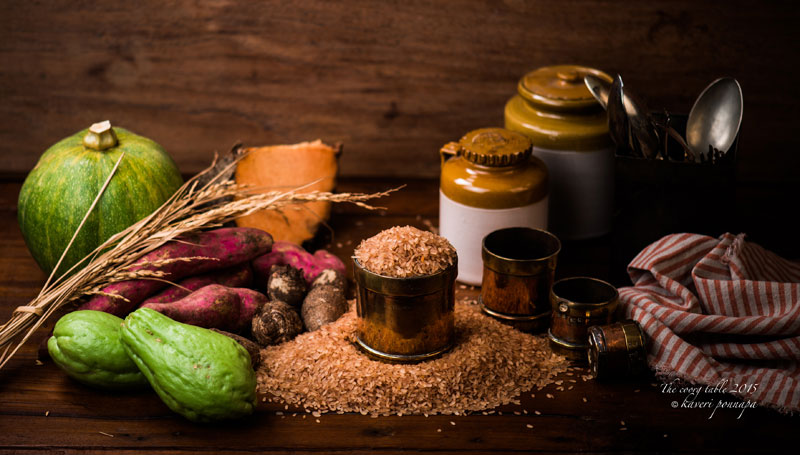 So when I asked, for someone, puthari was all about many voices joined in song: songs that have been sung for centuries. As people worked to welcome the harvest, there was a song, he remembered, for every task, for every moment of the day: a song to accompany the cleaning of a lane leading to the ancestral home; one for clearing the village green where the men and women would dance; another for the yard where the harvest would be gathered and even one with which to collect the creepers that would tie the sheaves of grain together. Everywhere there was a coming together, a gathering of people singing and working together, refreshing their ties with each other, the land was soaked with their songs so that it would flourish.
So when I asked, for someone, puthari was all about many voices joined in song: songs that have been sung for centuries. As people worked to welcome the harvest, there was a song, he remembered, for every task, for every moment of the day: a song to accompany the cleaning of a lane leading to the ancestral home; one for clearing the village green where the men and women would dance; another for the yard where the harvest would be gathered and even one with which to collect the creepers that would tie the sheaves of grain together. Everywhere there was a coming together, a gathering of people singing and working together, refreshing their ties with each other, the land was soaked with their songs so that it would flourish.  And as the harvest draws closer, the land does flourish–Coorg becomes more and more generous: pumpkins and beans, tubers, yams and greens come flooding into our kitchens. It’s the season for sweet potatoes and other buried offerings, particularly the large, weighty puthari kalanji, (Dioscorea esculenta), known as the Lesser Yam. This is so deeply etched on our memories as part of the harvest celebrations that Naren Thimmaiah, now at the helm of a world-renowned restaurant, gets nostalgic about the most rustic, humble treats created from yams and tubers. As a young boy growing up in Murnad, sweet potatoes, he recalls, were steamed skin-on –so it was a minor, engrossing ritual for children, peeling off every bit of the pinkish skin before snacking on the flesh mixed with sugar and ghee. There’s another a vivid image he shares of his mother cooking peeled puthari kalanji, tossing on a little rock salt before shutting the lid of the sakala (copper steamer). Most of the salt melted, but small chunks remained, to be deliciously mashed into a thin syrup of jaggery and eaten. With heaps of the cooked yam lying around in kitchens from the harvest through the many days of celebrations, they were of course the targets of raids by roaming gangs of small boys caught up in the general excitement. Steamed puthari kalanji, Thimmaiah recalls, was not so exciting unsweetened –but it was so much a part of the season, that the raids on kitchens continued all the same!
And as the harvest draws closer, the land does flourish–Coorg becomes more and more generous: pumpkins and beans, tubers, yams and greens come flooding into our kitchens. It’s the season for sweet potatoes and other buried offerings, particularly the large, weighty puthari kalanji, (Dioscorea esculenta), known as the Lesser Yam. This is so deeply etched on our memories as part of the harvest celebrations that Naren Thimmaiah, now at the helm of a world-renowned restaurant, gets nostalgic about the most rustic, humble treats created from yams and tubers. As a young boy growing up in Murnad, sweet potatoes, he recalls, were steamed skin-on –so it was a minor, engrossing ritual for children, peeling off every bit of the pinkish skin before snacking on the flesh mixed with sugar and ghee. There’s another a vivid image he shares of his mother cooking peeled puthari kalanji, tossing on a little rock salt before shutting the lid of the sakala (copper steamer). Most of the salt melted, but small chunks remained, to be deliciously mashed into a thin syrup of jaggery and eaten. With heaps of the cooked yam lying around in kitchens from the harvest through the many days of celebrations, they were of course the targets of raids by roaming gangs of small boys caught up in the general excitement. Steamed puthari kalanji, Thimmaiah recalls, was not so exciting unsweetened –but it was so much a part of the season, that the raids on kitchens continued all the same!  Across in Nalnad, this was the time to string together offerings of tender green cardamom pods; a time of feasts at ancestral homes, possible because of the collective work of many hands; the carnival atmosphere of folk plays (joyi kali) that travelled across villages; the excitement of practicing 11 different turns for the harvest dance –and fish curry. Puthari was the time, an elderly friend narrates, when everyone had fish on their tables. It was the signature dish of the season: chirau (shark); or onak meen (dried, salted fish); roasted prawns and crab pounded into chutneys and crab from the freshwater streams and fields marked the days after the harvest.
Across in Nalnad, this was the time to string together offerings of tender green cardamom pods; a time of feasts at ancestral homes, possible because of the collective work of many hands; the carnival atmosphere of folk plays (joyi kali) that travelled across villages; the excitement of practicing 11 different turns for the harvest dance –and fish curry. Puthari was the time, an elderly friend narrates, when everyone had fish on their tables. It was the signature dish of the season: chirau (shark); or onak meen (dried, salted fish); roasted prawns and crab pounded into chutneys and crab from the freshwater streams and fields marked the days after the harvest.  There’s plenty of food to choose from those days of extended celebrations: pandi curry of course, or puthari curry, an earthy mixture of dried fish, bitter gourd and local beans; sweet puthari payasa, with grains from the new harvest or toasty thambuttu. My favourite is thambuttu, the heavy, sweet pudding made with Coorg mara bale, a local variety of banana, mixed with powdered, roasted rice that carries a whiff of cardamom and tug of roasted fenugreek seeds. Sprinkled over with browned sesame seeds, curls of fresh coconut, sugar and a generous spoonful of hot melted ghee it’s a substantial dish. No wonder the line of an old song instructs people to feed thambuttu to the young men, so that they grow strong and bring glory to their clans and villages! No battles of old to face now, but I save a bottle of thambuttu powder to last me a year, its warm scent taking me right back to harvest nights in Coorg and my grandparents’ home. The soul of our rice-growing community is so deeply embedded within, we unconsciously take it everywhere we go. Aslesha Ancient Evenings and a Promise of PlentyMadappa remembers how her family carried the harvest spirit out of Coorg to wherever they happened to be living –her parents would organize huge puthari picnics, complete with outdoor cooking and target shooting with guns, so typically Coorg, building strong bonds of friendship and reciprocity in a place a long way from home.
There’s plenty of food to choose from those days of extended celebrations: pandi curry of course, or puthari curry, an earthy mixture of dried fish, bitter gourd and local beans; sweet puthari payasa, with grains from the new harvest or toasty thambuttu. My favourite is thambuttu, the heavy, sweet pudding made with Coorg mara bale, a local variety of banana, mixed with powdered, roasted rice that carries a whiff of cardamom and tug of roasted fenugreek seeds. Sprinkled over with browned sesame seeds, curls of fresh coconut, sugar and a generous spoonful of hot melted ghee it’s a substantial dish. No wonder the line of an old song instructs people to feed thambuttu to the young men, so that they grow strong and bring glory to their clans and villages! No battles of old to face now, but I save a bottle of thambuttu powder to last me a year, its warm scent taking me right back to harvest nights in Coorg and my grandparents’ home. The soul of our rice-growing community is so deeply embedded within, we unconsciously take it everywhere we go. Aslesha Ancient Evenings and a Promise of PlentyMadappa remembers how her family carried the harvest spirit out of Coorg to wherever they happened to be living –her parents would organize huge puthari picnics, complete with outdoor cooking and target shooting with guns, so typically Coorg, building strong bonds of friendship and reciprocity in a place a long way from home.  The puthari boté, the collective hunt is now a faded memory for most, but older people remember it as a very important part of our culture, when villagers and kinsmen hunted together according to sacred rules, sharing the wild game that came their way, celebrating together and forging close ties. It was at puthari, when coconuts were hung high on treetops and everyone showed off their marksmanship that an enthusiastic 10 year old Paruvangada Madappa coaxed and coerced his father into allowing him to fire a heavy, old-fashioned gun for the first time. His life as an ace marksman began at puthari. When he was a little older, he became such a good shot, that his sisters would send him out to hunt for the pot; as soon as a gunshot rang out, they would begin grinding spices for the meal, confident of their brother would return home with something for them to cook!
The puthari boté, the collective hunt is now a faded memory for most, but older people remember it as a very important part of our culture, when villagers and kinsmen hunted together according to sacred rules, sharing the wild game that came their way, celebrating together and forging close ties. It was at puthari, when coconuts were hung high on treetops and everyone showed off their marksmanship that an enthusiastic 10 year old Paruvangada Madappa coaxed and coerced his father into allowing him to fire a heavy, old-fashioned gun for the first time. His life as an ace marksman began at puthari. When he was a little older, he became such a good shot, that his sisters would send him out to hunt for the pot; as soon as a gunshot rang out, they would begin grinding spices for the meal, confident of their brother would return home with something for them to cook!  Madappa, his father and brother were unrivalled as marksmen, so at puthari, to give others a fighting chance, they were always offered the last shots at the coconuts, after the entire village had its turn. Children would cluster at the base of the tree when the brothers came forward, eyes fixed on the coconut, hands outstretched to catch the falling pieces –they knew it would be a bull’s eye!
Madappa, his father and brother were unrivalled as marksmen, so at puthari, to give others a fighting chance, they were always offered the last shots at the coconuts, after the entire village had its turn. Children would cluster at the base of the tree when the brothers came forward, eyes fixed on the coconut, hands outstretched to catch the falling pieces –they knew it would be a bull’s eye! 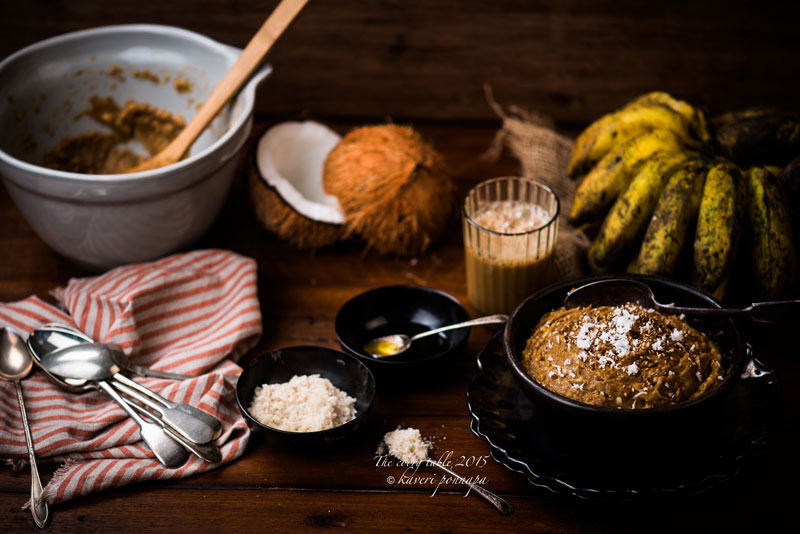 There’s a thread that runs through all the ceremonies, food, the sport, the dances and the songs, and Paruvangada Madappa tells another story that captures perfectly the spirit of this celebration. Puthari was the season for new clothes and his father would make the journey from their village to the nearest town to buy fabric for the family. Nothing mattered except that the cloth was thick, sturdy and long lasting. Once the choice was made, bales and bales of cloth, along with a distant relative who was a tailor, accompanied by his sewing machine, were all delivered to the village in a rattling cart. Some general measurements and a week’s furious sewing later, the girls of the house were given the first choice of clothes; then it was the Yerava tribals and their children who served the house who took their pick. The family members themselves came last, choosing from an assortment of sizes left over, in a gesture of solidarity with the people who helped them farm the land. On the festival day there was an extraordinary display of shorts, shirts, girls’ dresses, and ladies’ jackets all made from the same fabric. The generosity of the land was passed around as everyone welcomed and shared a harvest for which hands had worked long, hard hours together, building a community.
There’s a thread that runs through all the ceremonies, food, the sport, the dances and the songs, and Paruvangada Madappa tells another story that captures perfectly the spirit of this celebration. Puthari was the season for new clothes and his father would make the journey from their village to the nearest town to buy fabric for the family. Nothing mattered except that the cloth was thick, sturdy and long lasting. Once the choice was made, bales and bales of cloth, along with a distant relative who was a tailor, accompanied by his sewing machine, were all delivered to the village in a rattling cart. Some general measurements and a week’s furious sewing later, the girls of the house were given the first choice of clothes; then it was the Yerava tribals and their children who served the house who took their pick. The family members themselves came last, choosing from an assortment of sizes left over, in a gesture of solidarity with the people who helped them farm the land. On the festival day there was an extraordinary display of shorts, shirts, girls’ dresses, and ladies’ jackets all made from the same fabric. The generosity of the land was passed around as everyone welcomed and shared a harvest for which hands had worked long, hard hours together, building a community. 
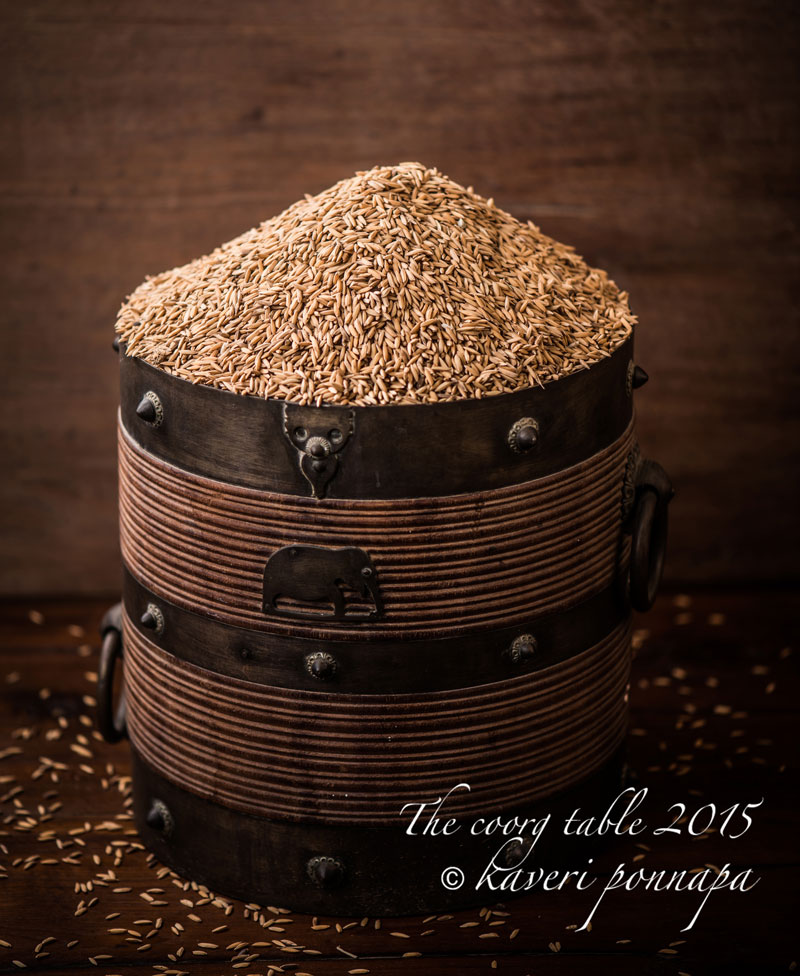
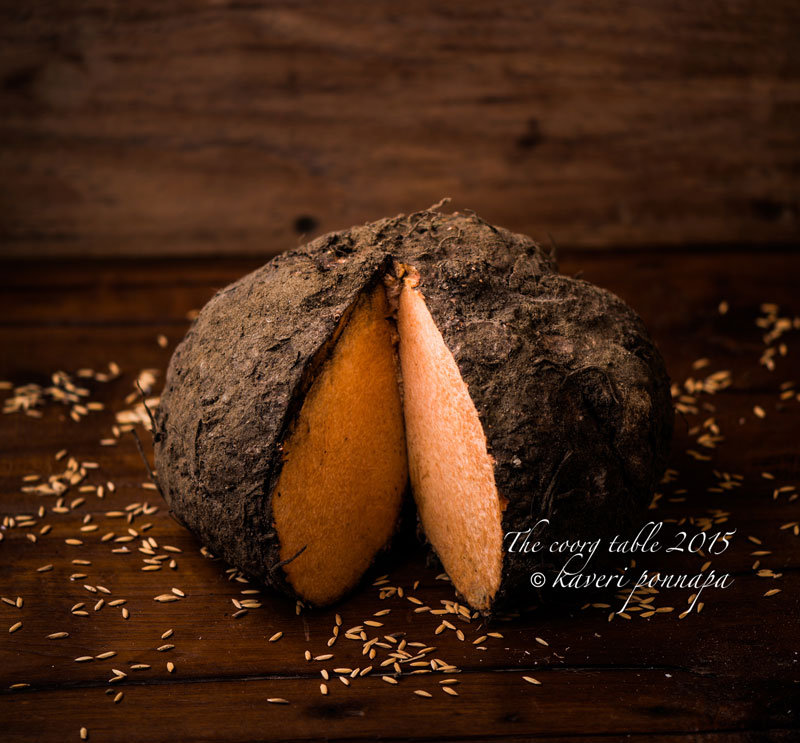
Photo Credits: Nithin Sagi
All Food Styling: Kaveri Ponnapa
Thank you for visiting this page. If you read something that you enjoy, or see an image that you like, please take a moment to write a response. Do look out for the recipes of all the food featured here in my upcoming cookbook.


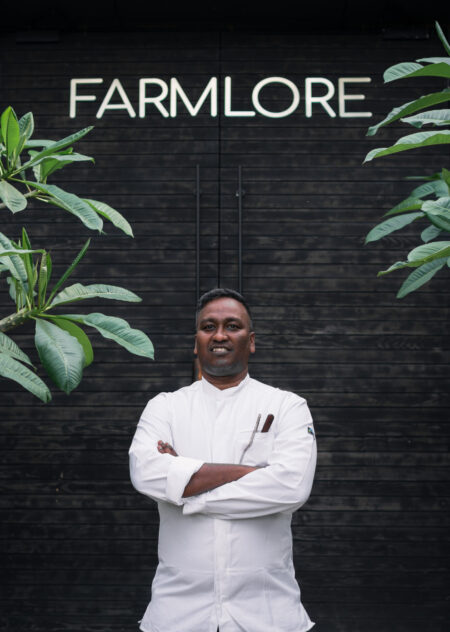
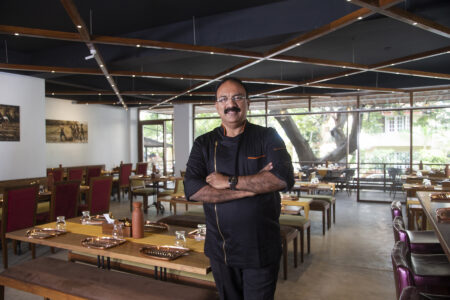

Awesome write up and spectacular photos! Happy Puthari to you and your family. The year has not been easy for most of us but little joys of Puthari remains especially if you are working out of or living in Kodagu. Thank you for this beautiful website!
Thank you for your good wishes and appreciation, and Happy Puthari to you and yours too, Aiyappa. Yes, it has been a very hard few years for Kodagu, but as you say, the small things make a difference. Today, a helping of Thambuttu made with Mara Bale from Kodagu brought back so many wonderful memories, and all the beauty of the place.
I’m so glad you enjoy the website—please keep reading. Let’s hope that rice cultivation never disappears from our land. Kaveri
Hello Kaveri,
Is there any other way in which I could use the ‘Thambutt’ podi. Im actually not a fan of banana’s, but at the same time I can’t resist myself to the waft of it. So can I add it in hot milk and drink it like a porridge? Or is there any other way you would suggest?
Thanks!
Warm regards.
Hi Sachin, you can make a delicious pudding by cooking the thambuttu powder in water, and adding jaggery syrup to it. This way you skip the bananas, but keep every bit of the toasted, malty flavour and fragrance that you enjoy. You can read more about it here: https://kaveriponnapa.com/coorg-berembuttu-roasted-rice-pudding.html
Enjoy this treat! Kaveri
Hi Kaveri,
I’m so happy to find your thambuttu podi recipe! Living in the US I wait for my mum to bring some back when she visits Coorg. But I’ve always wanted to make my own, so I appreciate you sharing this.
A quick question about the rice – can I use sona masoori to make the podi or do you recommend another type of rice. I’m not sure I’ve seen boiled rice here as I usually use sona masoori for my dosas.
Thanks a bunch!
Welcome to The Coorg Table, Akshaya, I hope that you’ll soon have a regular supply of thambuttu podi that you have made yourself. To answer your question, the rice, which is actually parbolied, is essential to the podi. The grain is completely different after the process. I did a quick search on Amazon, and I found several brands of Indian parboiled rices being sold, including the 24 Letter Mantra idly rice, which is organic.I also used to buy a brand called Uncle Ben’s when I lived overseas. Do have a look. You could check Asian grocery stores, I’m sure they will stock parboiled rice too.Make sure you go for the short grain rice rather than the long grain.Good luck, and I’d love to know how it turned out! Kaveri
This is such a wonderful read. The traditions are a window to our history and food becomes a story teller sometimes.
This Thambuttu is such a healthy desi cereal. And almost instant as well. Gluten free too 🙂 I am going to make it soon. Thank you for all the good things you bring to this table for us to relish.
Thambuttu is a rich and filling dish, Sangeeta, and I have recently discovered something else very interesting about the powerd mix that I will share very shortly. Thank you very much for visiting the page,I’m so glad you enjoy the posts, it’s always a joy to hear from someone who does. Kaveri
Hi mam, am Chenanda Sunil Subbaiah from ITC Windsor, its really great of u for your commitment u did to make the authentic Coorg food more popular through your website. When I saw the images of the food,, it’s really mouth watering (YUMMY). PLEASE KEEP DOING. I think I should read all about Coorg from your website….. Thank You very much. And please keep coming to ITC Windsor, it’s our pleasure to serve you n sir. Thank You once again.
Thank you very much for visiting this page, Sunil, and I’m so glad you liked the images of our simple but delicious food. Please do take your time and read through the blog. I always look forward to our visits to ITC Windsor, and it’s a real pleasure to see two of my dishes,both very traditional, on the menu of this excellent restaurant. Best wishes.Kaveri
Good information every Coorg should read it.
Thank you, Rana. Please keep visiting these pages. Best wishes.Kaveri
happy puthari kaveri. wishing you all a happiness and health.
as always great read.
Thank you very much for your good wishes, Nithin- it was a peaceful and beautiful Puthari for us. Kaveri
Yes….Puthari is here….like every year….but the excitement is just the same…may be as the years pass by….you get more nostalgic about the way you used to celebrate the festival in the younger days and talking about it endlessly never tires you! Celebrating the Puthari these days with the constraint of your schedules is still fun and that’s where reliving the past makes up for the lost charm and that’s exactly what your article has done to me Mrs.Ponnapa! I really appreciate the detailing which has gone into this article to make us understand the whole festivity in a fuller sense. The picture of Marabaale is again a true original! And as usual a Collector’s piece for sure!
A very happy and blessed Puthari to you and your family, Thimmaiah. The beauty and charm of Puthari are very special, and thanks to all of you who are happy to share your many stories with me, it’s even easier to write about it, and try and capture the spirit of this festival we all love. Look forward to seeing you at The Coorg Table. Warm wishes.Kaveri
Wow Radhika ( Kaveri),
This is truly a work of art!! You have a way of telling stories that make us want to hear more & more. The recipes and photos are priceless. am sharing with my American friends who are also”foodies”being manufacturers of Food Ingredients & love Coorg recipes.
On this happy occasion of Puthari festival, Madappa joins me in wishing you all a very happy Puthari and may Goddess Cauvery & Lord Iguthappa shower you with abundant good health, happiness, peace & prosperity .
Warm regs.
Aslesha
A very happy Puthari to you Aslesha and Madappa, and to all your loved ones,with every blessing that this beautiful time of the year brings us. I am so pleased that you enjoyed reading the post-it was inspired by Madappa’s wonderful stories of ‘the spirit of puthari in Coorg. I can’t thank you both enough for having shared your stories so generously for everyone to enjoy. Warm wishes.Kaveri
Nice narration with wonderful images…Above story tells perfectly about kodavas..they are not only known for bravery they are good at heart…Girls are treated equally…household help are treated as one among their family…wow!! Really amazing…Thanks for the wonderful writing and lovely images…Happy Puthari…
Hello Kaverappa, a very happy Puthari to you and all your family. I hope that you are in Coorg right now, celebrating with all of them. Thank you for your constant appreciation and support, it makes the blog worthwhile. May our Kaveramme and Lord Igguthappa bless you always. Kaveri